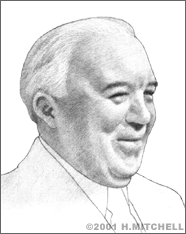Richard Reynolds
The entrepreneurial spirit clearly runs in the Reynolds family: Richard S. Reynolds, creator of “Reynolds Wrap” was the nephew of tobacco king R. J. Reynolds. In fact, the younger Reynolds worked for his uncle during the summers of his youth, until in 1919, he started his own business, the U.S. Foil Co., supplying tin-lead wrappers to cigarette and candy companies.
In the 1920s, the price of aluminum dropped, and Reynolds switched from tin to this new lightweight, non-corrosive metal. The material’s advantages were numerous, including that it could be rolled much thinner than existing metal packaging and was less expensive because of the greater yield of foil per pound of metal. In addition, aluminum foil was more brilliant and more appealing to the eye. Moreover, it had protective qualities, which made it valuable as a packaging material.
In 1924, Reynolds and his Louisville, Kentucky-based company bought the enterprise that made Eskimo Pies, which were wrapped in foil. Four years later, Reynolds purchased Robertshaw Thermostat, Fulton Sylphon, and part of Beechnut Foil, adding the companies to U.S. Foil to form Reynolds Metals. In 1926, the company began using aluminum foil as a packaging material for the first time. By 1930, Reynolds sales had reached nearly $13 million. Continuing to expand and grow, the company moved its headquarters to New York City. The company created the first high-speed, gravure-printed foil, aluminum bottle labels, heat-sealed foil bags for foods and foil-laminated building insulation paper. In 1938, the company’s executive offices were moved again, this time to Richmond, Virginia.
Reynolds could see in the late 1930s that it was possible that the United States would enter World War II. He knew that meant demand for aluminum would increase, as it could be employed in many of the supplies troops would need overseas. At that time, Reynolds Metals began mining bauxite (aluminum ore) in Arkansas in 1940 and opened its first aluminum plant near Sheffield, Alabama, the following year. In 1947, the company came up with its most famous creation, Reynolds Wrap Aluminum Foil, which sells extraordinarily well in supermarkets all over the world today and transformed food storage everywhere.
Meanwhile, Reynolds Metals pioneered the development of aluminum siding in 1945, and R.S. Reynolds began predicting a growing demand for additional aluminum during peacetime. He knew it wouldn’t take long before new aluminum-producing facilities would need to be built to meet demand. Reynolds Metals Company leased, and later bought, six government plants that were up for disposal.
Reynolds continued to grow, opening mining operations both in the U.S. and around the world. The company also began to introduce new consumer and industrial products -- in 1982, for example it introduced Reynolds Plastic Wrap. The company remains the second largest aluminum company in the United States (behind Alcoa) and the third largest aluminum company in the world (behind Canada's Alcan Aluminum).
Over the years, Reynolds' four sons had each played an important part in the company's success. In 1948, at a Board of Directors meeting, Reynolds announced that he would be turning over the leadership of the company to his sons. He remained actively involved in the company, however, until his death in 1955.


